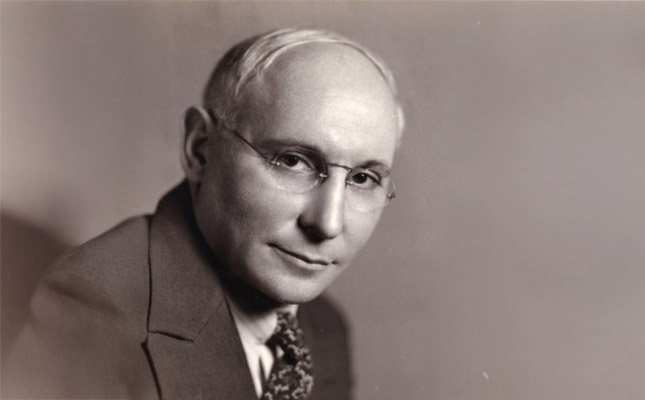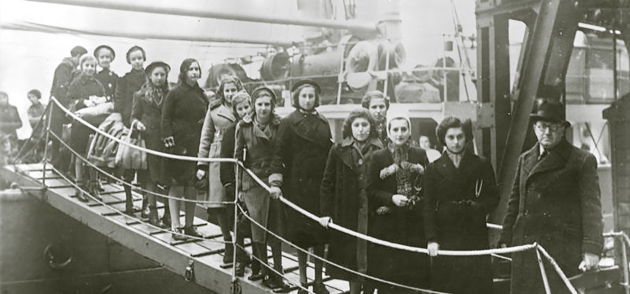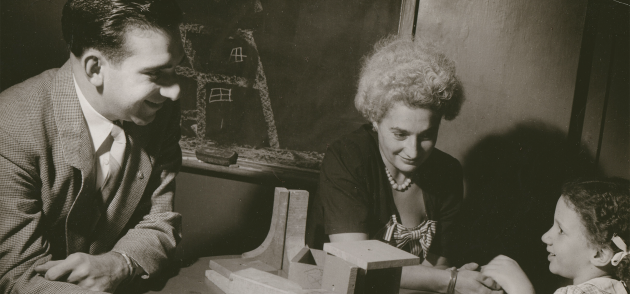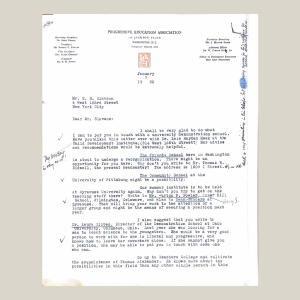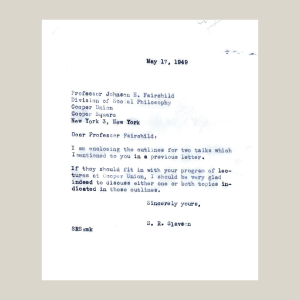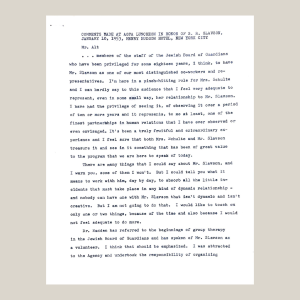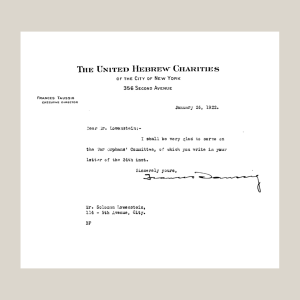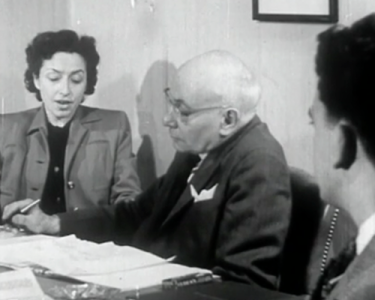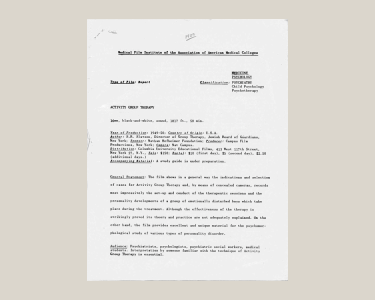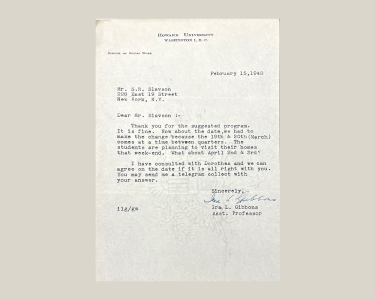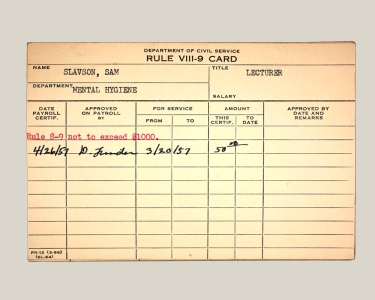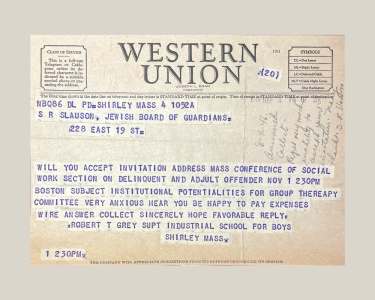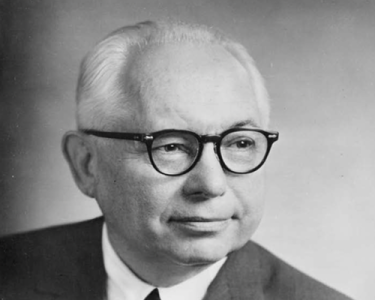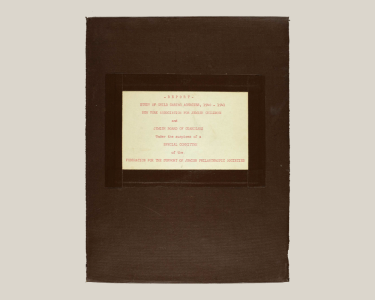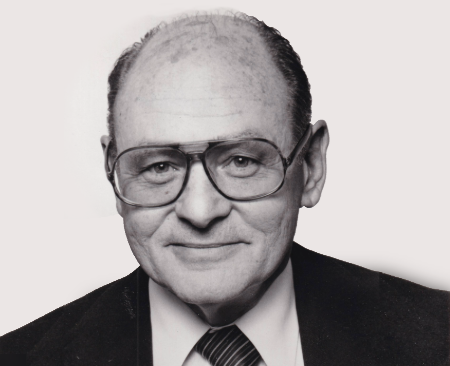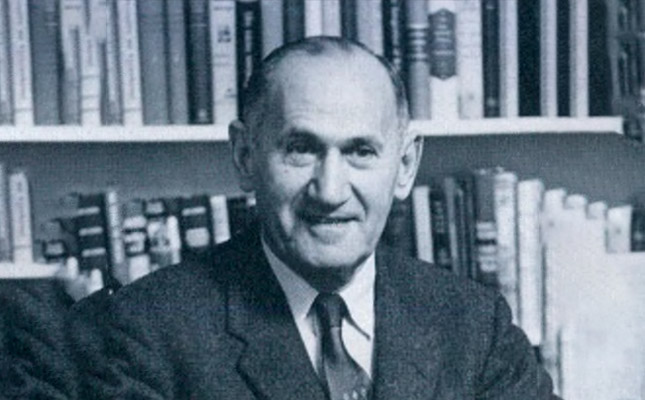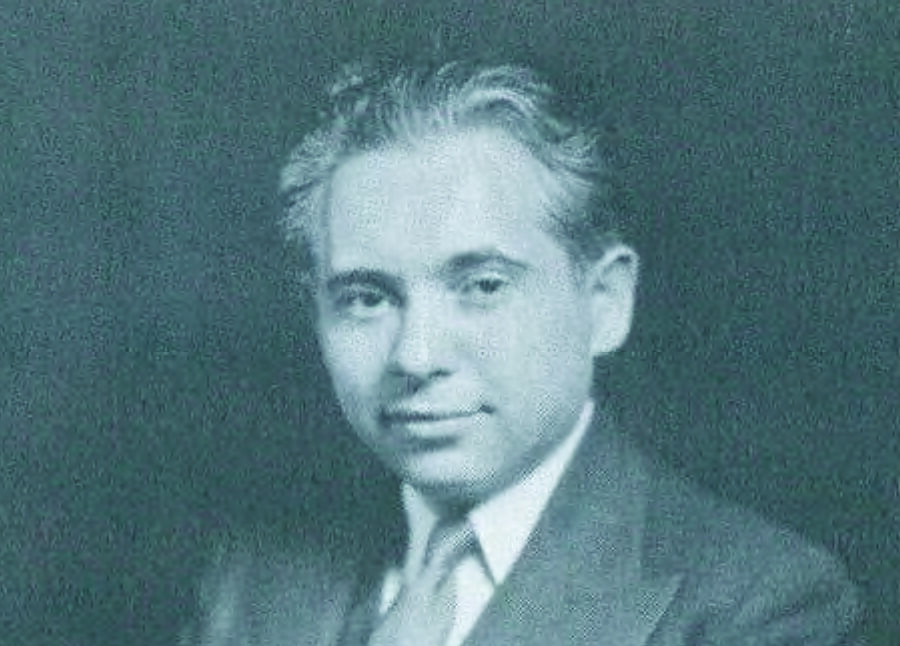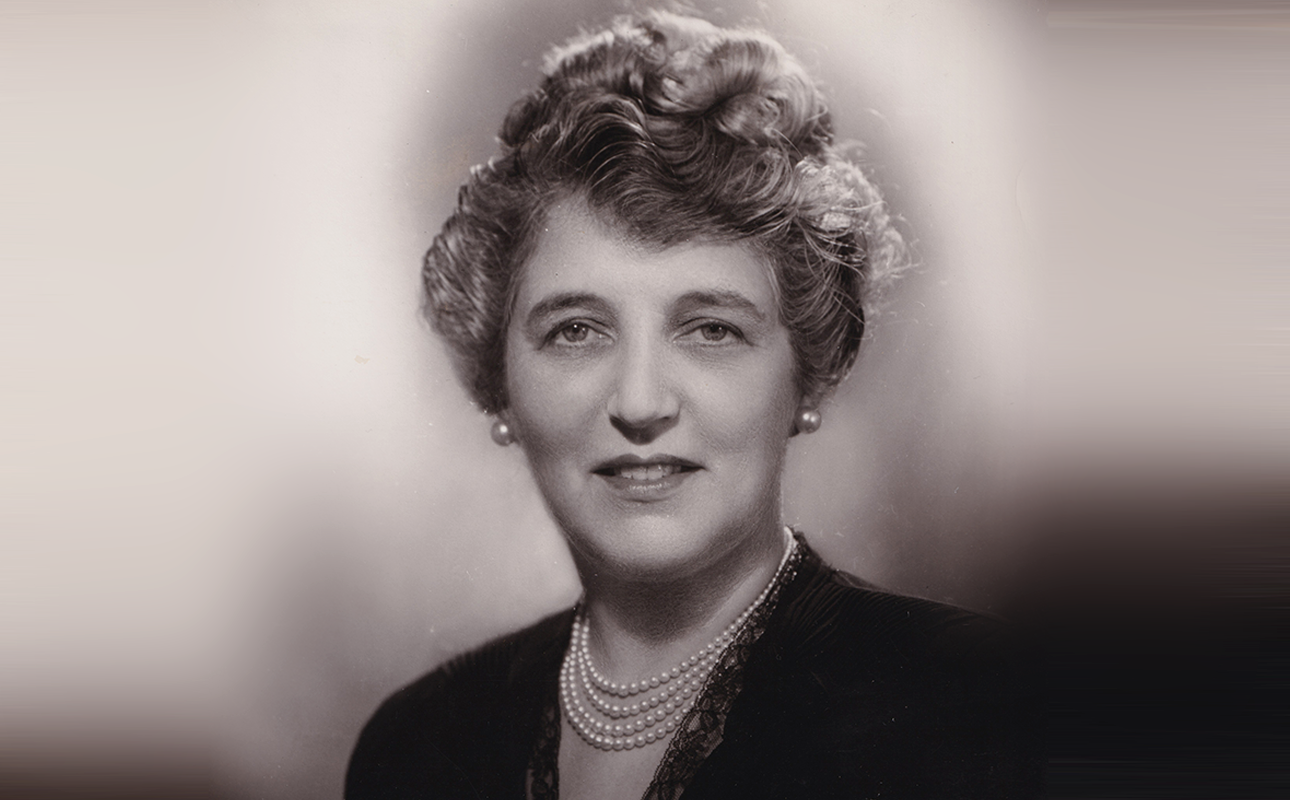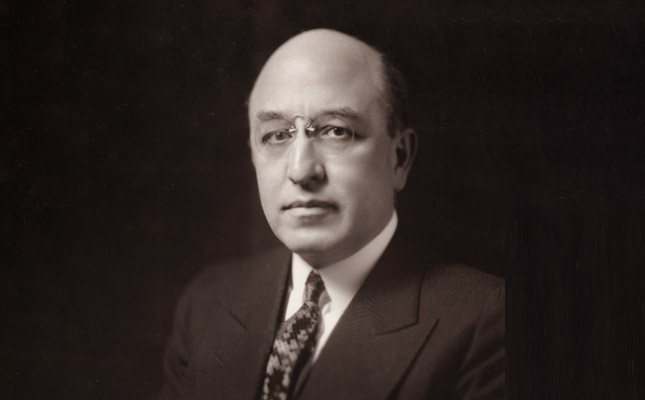Samuel Richard Slavson was a prominent figure in the fields of progressive education and child guidance and is widely recognized for his pioneering work in the development of child and adolescent group psychotherapy.
Director of Group Therapy, Jewish Board of Guardians, 1934-1956
Samuel Richard (SR) Slavson was born in 1890 in the central Ukrainian city of Poltava, which was then part of the Russian Empire. In 1903, he emigrated to New York City with his parents and younger brother, Jewish Board of Guardians colleague and executive director Dr. John Slawson. Though he was not a formally trained clinician, SR Slavson made key contributions to the nascent field of child and adolescent group therapy in his role as Director of Group Therapy at the Jewish Board of Guardians from 1934 until his retirement in 1956.
Early Career
Slavson joined the Socialist Party of America at the age of 14, worked his way through obtaining a bachelor’s degree in civil engineering from Cooper Union’s evening school, and became increasingly interested in mental hygiene and psychology as he navigated his early career as a labor activist and progressive education worker in New York City. He worked for several years as an educator and administrator at the progressive Walden School in Manhattan; during the 1920s he also ran creative writing groups at the Madison House and 92nd Street YMCA while deepening his mostly self-directed studies in principles of child guidance and psychiatric case work at Teachers College, Columbia University. Informed by both the child guidance and Freudian psychoanalytic movements of the time, Slavson brought his unorthodox background at the intersections of progressive education, social welfare, and community and labor organizing to bear on all aspects of his clinical thinking.
The Father of Group Therapy
It was in 1934 at the Jewish Board of Guardians’ Child Guidance Clinic that Slavson first introduced the concept of a “creative recreational program” for small groups of girls who exhibited signs of social maladjustment. He and his colleagues observed that, when given the permissive space and freedom to participate in creative activities from arts and crafts to poetry—in a setting that was free from didactic or judgmental elements—the girls’ behavior markedly improved, as reported by the Big Sisters of these participants. Slavson conducted in-depth studies of session reports to better understand what might be contributing to the girls’ psychological improvement, and concluded that it was not the creations themselves but rather “the group interactions…and relations in the permissive environment and the neutrality of the leader-therapist that rendered the salutary results.” With the backing of the agency which was at this time led by his brother John Slawson, Slavson began “Group Therapy” project. The project, embedded within the Child Guidance Clinic, quickly expanded to the Jewish Board of Guardians’ growing number of clinics and offices across the city’s boroughs.
In 1942, Slavson co-founded the American Group Psychotherapy Association. Through the war and post-war years, he and his colleagues expanded the practice of group therapy to incorporate work with mothers, began new clinics across the city’s boroughs and a therapeutic nursery, and secured federal funding from the NIMH in its earliest years for work on group therapy research and training. As his career progressed, his interests expanded further into the realm of social psychiatry and group relations.
In 1950, he completed a four-part film series on Activity Group Therapy, which he used as a training tool for social workers, child guidance clinics and other professionals in the US and abroad. The videos were one among many tools in his training arsenal: Slavson was a prolific writer, tireless teacher, and dedicated evangelist of the approach who taught and consulted on group therapy for hundreds of people and organizations over the years.1
Embodying Complexity
Dr. Slavson was also known by some colleagues and competitors to be a polarizing figure, with a reputation for being stubborn and domineering. Some colleagues, including Jewish Board of Guardians social worker Betty Gabriel, felt that he took undue credit for the model of group therapy while some of the most visionary and effective women clinicians like Gabriel, who were mostly trained as social workers and who were also running and innovating groups, went underrecognized for their work.This dynamic, with its hierarchical interface between psychiatry, social work, and treatment, was part of a tradition that dominated in mid-century psychotherapeutic practice and scholarship. In this model, there was usually a “master clinician” —most often a white, male psychiatrist—who trained, supervised, and provided consultation to the social workers who performed most of the actual clinical work, from facilitating groups to working with families and offering individual therapy to clients. This clinical tradition was part of a broader culture in which men were systematically afforded preferential treatment, status, and authority compared with their female counterparts – especially within the medical professions.
Legacy
SR Slavson retired from the Jewish Board of Guardians in 1956 but continued to teach, consult, and speak well into the late years of his life. Over the course of his career, he authored nearly 200 articles, book chapters,2 and conference presentations and was the recipient of many prestigious awards in the field of mental health. He passed away in 1980 and his papers are mostly housed at New York University’s Archives and Special Collections. They contain a trove of information about his life and contributions, as well as the movements in which he was most deeply invested—particularly group therapy at the Jewish Board of Guardians.
Notably, much of the primary source material, including Slavson’s correspondence with fellow professionals across the globe during his JBG years, reveals an empathic, quirky, and humorous side that is mostly absent in more official accounts and analyses of his life and contributions. He was clearly revered by many and was perhaps less self-serious at heart than he outwardly projected. Affectionately referred to as “Slavie” in many letters from trusted friends and collaborators, Samuel Richard Slavson’s at times dogmatic personality may have obscured a sensitivity and deep concern for humanity and the welfare of society’s most vulnerable, which shines through quite clearly in the archival record and his accomplishments at the Jewish Board of Guardians.
- He pursued collaborations with organizations and governmental actors abroad, including the Tavistock Clinic of London and groups working in the newly formed state of Israel. ↩︎
- Slavson’s case study “Problem Delinquent Girls” was featured as a chapter in the 1989 Great Cases in Psychoanalysis, side by side with cases of heavy hitters including Sigmund Freud, Carl Jung, Sandor Ferenczi, Alfred Adler, and Karen Horney. ↩︎
Reference List, Bibliography and Research Resources
- SR Slavson Papers, New York University Archives & Special Collections
- Jewish Board for Family and Children’s Services Internal Records Collection, Hawthorne NY
- Bion, Wilfred R. Experiences in Groups. New York: Basic Books, 1959.
- Rachman, Arnold W, and Richard R. Raubolt. 1984. “The Pioneers of Adolescent Group Psychotherapy.” International Journal of Group Psychotherapy 34 (3): 387–413. doi:10.1080/00207284.1984.11491393
- Rachman, Arnold W. “S. R. Slavson: A Personal Reaction.” Group 1, no. 1 (1977): 56–64. http://www.jstor.org/stable/41717842.
- Scheidlinger, Saul, And Gerald Schamess, “Fifty Years Of AGPA 1942-1992: An Overview,” American Group Psychotherapy Association, accessed July 25, 2024. https://www.agpa.org/home/about-us/agpa/50-year-history
- Slavson, S. R. An introduction to Group Therapy.New York: The Commonwealth Fund, 1943.
- Slavson, S. R. Character Education In a Democracy.New York: Association Press, 1939.
- Slavson, S.R. Creative Group Education. New York: Association Press, 1938.
- Spotnitz, Hyman. 1971. “In Tribute to S. R. Slavson.” International Journal of Group Psychotherapy 21 (4): 402–5. doi:10.1080/00207284.1971.11492124.
